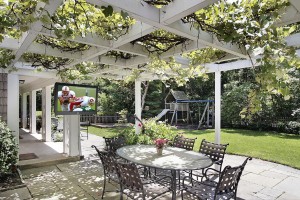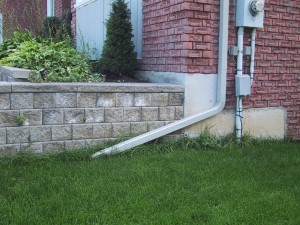Outdoor Living Space Project Tips
Spring is a popular time for homeowners to get outside and apply some good old sweat equity to their home investment. Winter months cooped up inside can spawn some creative ideas and solutions that backyard DIY’ers can’t wait to apply. But unfortunately, perhaps in their haste, some homeowners are guilty of poor planning and fact-finding – or none at all – before beginning their project.
If you are planning an outdoor improvement to your home, consider the following list of pitfalls to avoid:
1. Improper Drainage
 Improper drainage is unfortunately a common problem with outdoor living space features. But thankfully, with some proper planning, this is one problem area that can be easily avoided.
Improper drainage is unfortunately a common problem with outdoor living space features. But thankfully, with some proper planning, this is one problem area that can be easily avoided.
Because patios and outdoor walkways are often next to the house itself, incorporating a proper slope is essential when adding one. Improper drainage of patios, walkways and the ground below a deck can lead to water pooling next to the basement wall – never a good situation. When that happens, it can lead to a leak and resulting mold and rot – not to mention the cost to repair.
Ensuring a proper slope angle is critical in the construction phase. A drop of 2.5 cm over 2.5 m (1 in over 8 ft) is generally considered to be suitable for walkways and patios to ensure rainwater and snow melt find their way away from the home. Make the slope angle beneath a deck more severe, since no one will be walking on it and you definitely don’t want to have to make repairs under there later.
It’s important to note that even though a sufficient slope angle in itself is relatively easy to attain, unless the ground underneath is properly graded and compacted, gradual settling can reduce that slope to nothing – or even reverse it! So be sure to properly compact the soil to avoid settling and future problems.
2. Insufficient Depth of Base
The material you add below the finished surface is critical to success. Subsurface preparation can depend on the actual top surface you have chosen. Be sure to apply the recommended amount of gravel and/or sand to provide the proper base for your project.
3. Inconsistent Compaction
Patios made of stone – made-man or natural – allow water to drain between the stones, generally considered a good thing. But this means extra attention is needed to avoid a low spot on your patio. If one does start to form, the pooling water will cause the problem to snowball.
To avoid low spots from forming on your patio, ensure the compaction of the substrate material is consistent throughout the area. And for clay soils, make sure the base material itself has a consistent slope angle with no low points before you add sand or gravel.
4. Downspouts that Drain onto Walkways
 Even with proper slope angles applied to your patio or walkway, having a downspout drain onto one is not recommended. It leads to premature and uneven wear of the surface. And in winter, ice build-up can easily cause water to pool next to your foundation wall. Plus, the melt water can make walkways treacherous to negotiate when it freezes again.
Even with proper slope angles applied to your patio or walkway, having a downspout drain onto one is not recommended. It leads to premature and uneven wear of the surface. And in winter, ice build-up can easily cause water to pool next to your foundation wall. Plus, the melt water can make walkways treacherous to negotiate when it freezes again.
5. Improper Lighting and Electrical Receptacles
Insufficient or improperly-placed lighting and wiring is another common problem with outdoor living spaces. From a safety standpoint, laws require you to ensure all electrical lines are properly protected so that no one accidentally cuts into one when gardening. Specific codes can vary from municipality to municipality, so make sure you know exactly what is required before you begin.
Also, all plugs need to be GFI protected (ground-fault interrupted) and properly positioned with covers in place to ensure protection from the elements and the safety of your family, friends and pets.
 The type of lighting you choose and how you position your lighting are also areas that involve proper planning. Avoid lighting that produces a glare – both for safety and for better ambience. Be sure to provide sufficient lighting for walkways and stairs, too. That is where most accidents occur. Motion-activated lighting can be a good option here. Just be sure to also have them on a timer so that they do not turn off and on all night long when only the nocturnal beasts are about.
The type of lighting you choose and how you position your lighting are also areas that involve proper planning. Avoid lighting that produces a glare – both for safety and for better ambience. Be sure to provide sufficient lighting for walkways and stairs, too. That is where most accidents occur. Motion-activated lighting can be a good option here. Just be sure to also have them on a timer so that they do not turn off and on all night long when only the nocturnal beasts are about.
Comfortable outdoor living space is valued highly by today’s home owners– and home buyers. But as with other valued areas of a home, poor workmanship and improper additions can lead to problems and expenses down the road. And if you plan to sell, it can scare-off potential buyers and reduce perceived value. So be sure any outdoor projects you have on your horizon are well-planned and thoroughly thought-out before initiating, to maximize the ROI for your efforts.
May’s Monthly Tips
1. Check and trim vines or shrubs that may affect airflow around your air conditioning equipment.
2. Ensure the air conditioning unit is level and the pad has not shifted over the winter.
3. Trim tree branches that are touching or overhanging your roof or siding.
4. Check wood siding for damage or rot.
5. Check exterior mortar, masonry or stucco for deterioration or cracks. Cracks or damage to a stucco wall can cause water penetration behind the surface.
Courtesy: Joe Roberto, Lighthouse Inspections
